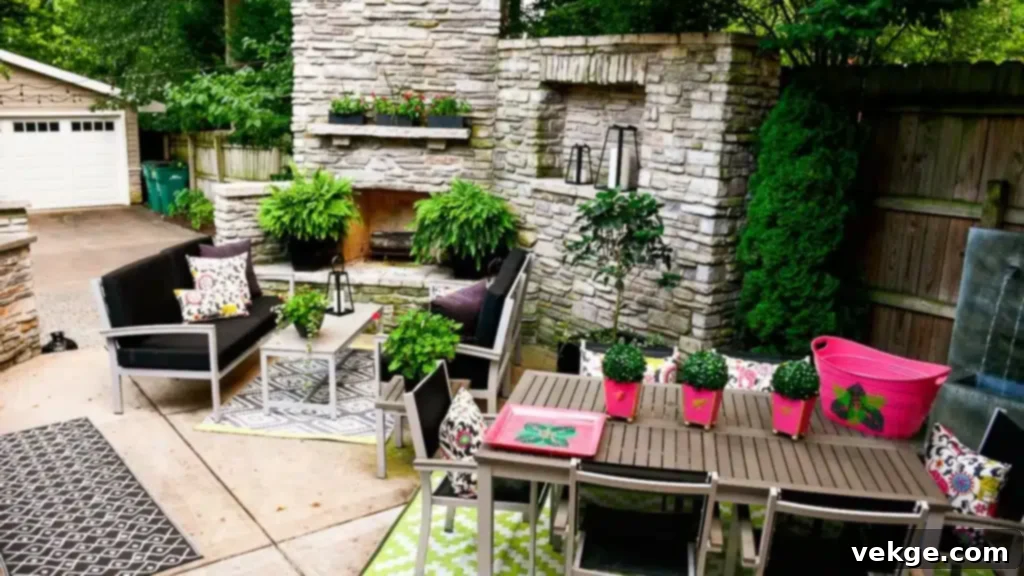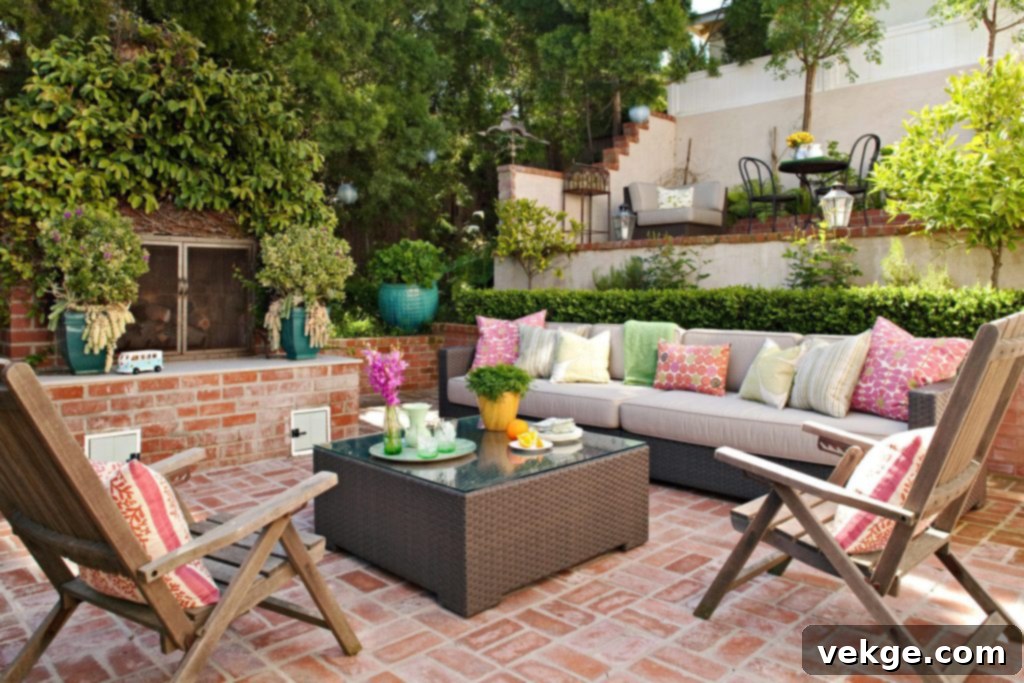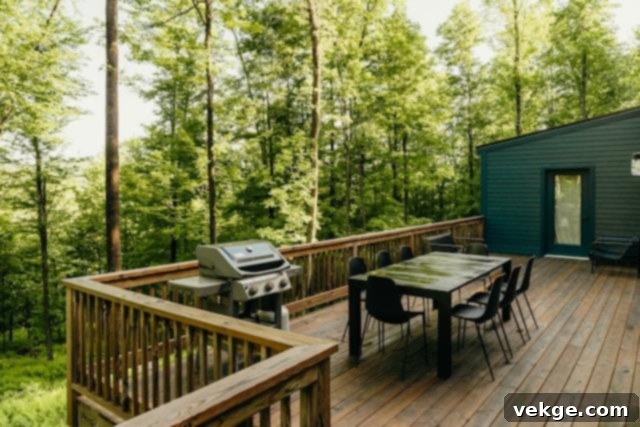Transform Your Outdoor Space: The Ultimate Guide to Designing Functional and Beautiful Exterior Living Areas
Designing the outdoor area of a house offers architects, designers, and homeowners a unique realm of creativity and freedom. Unlike the confined boundaries of interior spaces, which are often limited by walls, ceilings, and load-bearing structures, the great outdoors presents an expansive canvas. This absence of rigid architectural constraints allows for boundless imagination, enabling the creation of spaces that are not only aesthetically captivating but also seamlessly integrated with nature.
Nevertheless, achieving an ideal and functional layout for any outdoor space demands a significant level of expertise, meticulous planning, and a dedicated design phase. The thoughtful consideration and precision typically applied to interior design are equally, if not more, necessary when approaching a garden, patio, or terrace. Crafting an exterior living area that truly enhances your property and lifestyle requires strategic decisions regarding flow, functionality, aesthetics, and durability. This comprehensive guide will provide invaluable tips for selecting the best layout and design elements for your outdoor sanctuary.
Begin with a Central Focus to Anchor Your Outdoor Design

Just as a living room benefits from a fireplace or a striking art piece, establishing a focal point is paramount when designing any outdoor area. A well-chosen focal point serves as a visual anchor, drawing the eye and providing a starting point from which the rest of your design can organically unfold. This central element could be a majestic piece of wall art, a tranquil pond or a dynamic fountain, a substantial and eye-catching potted plant or a cluster of vibrant flora, or even a distinctive piece of outdoor furniture that commands attention.
Once your central focus is established, you can meticulously develop the surrounding design features. This could involve arranging pathways that lead towards it, positioning planting beds to frame it, or creating seating areas that offer the best view. To cultivate a truly comfortable and inviting outdoor living space, it’s essential to designate specific zones. A conversation area, for instance, is vital for social interaction. Here, you can thoughtfully arrange comfortable outdoor furniture—such as plush chairs, versatile stools, ergonomic benches, or expansive outdoor sofas—around a captivating feature like a modern fire pit or a chic coffee table. This not only enhances the visual appeal but also fosters an environment conducive to relaxation and meaningful connection.
Determine the Purpose: Tailoring Your Outdoor Space for Optimal Functionality
A fundamental step in successful outdoor design is clearly understanding the intended use of the space. A garden primarily designated for lively dining experiences and entertaining will require a significantly different layout and material selection compared to an area designed for quiet sunbathing, serene contemplation, or enjoying panoramic views. Consider clients who frequently host elaborate dinners, spirited barbecues, or large social gatherings in their gardens.
For such social hubs, opting for a durable paved surface, perhaps with a circular or oval shape, naturally centers the dining table as the undeniable focal point of the outdoor area. A round table, devoid of corners, inherently symbolizes communication and closeness, fostering intimacy among guests. Conversely, expansive square or rectangular paved surfaces are often more suitable for larger outdoor spaces primarily focused on relaxation and sprawling comfort. These shapes lend themselves well to arranging multiple seating configurations or accommodating extensive lounge setups.
For instance, an array of designer loungers or daybeds arranged within the garden might benefit from regular polygon-shaped paving, complemented by distinct, straight walkways, consciously avoiding the more intimate circular or rounded lines. Strategic paving not only defines areas but also sets the tone for the space. Companies like Coughlin Concrete specialize in helping you elevate your property with custom concrete solutions. Their expertise allows for tailored designs, from decorative stamped concrete patios perfect for alfresco dining to durable, expansive slabs ideal for large relaxation zones, ensuring the paving perfectly fits the purpose and aesthetic of your outdoor space. The versatility of concrete also allows for various finishes, colors, and textures, further customizing the area to your specific needs.
Think About the Lifestyle: Designing for Personal Habits and Preferences
To truly choose the ideal layout for an outdoor space, it’s crucial to delve deeply into the client’s lifestyle, avoiding superficial assumptions. If the client relishes hosting numerous parties, social gatherings, and making their home a vibrant hub of activity, the outdoor area should inherently adopt a flexible, open, and robust design. This means creating ample circulation space, defining multiple informal seating zones, and ensuring easy access to amenities like outdoor kitchens or bar areas.
For spaces primarily used for energetic parties, consider positioning them slightly apart from the main house, if the property size permits. This strategic separation can help mitigate issues with loud music or boisterous noise impacting the interior of the home or disturbing neighbors. Given the potential for large gatherings, the garden should maximize paved areas according to the available space, providing durable, easy-to-clean surfaces that can withstand heavy foot traffic. The materials selected for these high-traffic zones should also meet specific technical requirements for slip resistance, weather durability, and ease of maintenance.
Understanding a client’s lifestyle is equally crucial for designing more serene and contemplative spaces. If the client cherishes peace, solitude, and quiet reflection in their garden, a thoughtfully landscaped area offering stunning sunset views and various cozy, intimate corners might be far more suitable. Each of these distinct zones could serve a unique purpose: a secluded bench for resting, a shaded pergola for reading, a small bistro set for intimate dining, or a comfortable swing for quiet chatting. Incorporating elements like calming water features, fragrant plants, and soft, natural textures can further enhance the tranquil atmosphere, creating a personal oasis tailored precisely to the client’s desire for calm and rejuvenation.
Choose Classic and Durable Furniture for Lasting Appeal

Maintaining a stylish and inviting patio or deck can become a constant battle if your outdoor furniture quickly succumbs to damage, fading, or wear and tear. To preempt these issues and ensure longevity, consider making a smart investment in durable, weather-resistant outdoor furniture. Thankfully, the market offers a vast array of high-quality outdoor furniture options, with many reputable brands available both in brick-and-mortar stores and conveniently online. When selecting materials for your outdoor living area, keeping these expert tips in mind will guide you toward choices that offer both aesthetic appeal and practical resilience:
- Wood: While wood, such as teak, acacia, or cedar, is a perennially popular choice for its natural beauty and warmth, it often requires significant maintenance, including regular sealing and oiling, to prevent weathering and decay. If you appreciate the organic look of wood for your garden or backyard but prefer lower maintenance, consider opting for synthetic wicker or rattan chairs and tables. Modern synthetic versions are crafted from UV-resistant polyethylene resin, offering the aesthetic charm of natural fibers without the susceptibility to rot, fading, or splintering.
- Metal: Aluminum is lightweight, rust-resistant, and requires minimal maintenance, making it ideal for modern designs. Wrought iron, while heavier and more prone to rust, offers a classic, ornate look and exceptional durability. Stainless steel is another excellent, rust-resistant option, often found in contemporary designs.
- Cushions and Fabrics: Invest in outdoor cushions made with performance fabrics like Sunbrella or Outdura. These materials are engineered to be fade-resistant, water-resistant, and easy to clean, ensuring your seating remains vibrant and comfortable through various weather conditions.
- Easy Storage Solutions: If you anticipate needing to store your furniture during off-seasons or to protect it from extreme weather, explore patio furniture sets that are designed for easy stacking, folding, or disassembling. Modular sectional pieces can also be reconfigured or stored more compactly. Alternatively, consider investing in high-quality, waterproof furniture covers to extend the life of your pieces year-round.
Select the Roof Terrace Furniture Carefully: Maximizing Urban Outdoor Spaces
The world of outdoor design encompasses numerous types of spaces, each with its own unique characteristics and challenges. From sprawling gardens to intimate balconies, and significantly, roof terraces, furniture must seamlessly integrate with these elements, depending on the specific setting and the desired mood you wish to create. It is crucial to take your time and exercise careful consideration when selecting the right furniture, as it can profoundly impact the overall ambiance, functionality, and perceived spaciousness of your outdoor area, especially in urban environments.
The available space, often at a premium in city settings, will heavily influence how you design your outdoor area. While not all city apartments boast balconies, many compensate with increasingly popular roof gardens or shared communal terraces. These elevated spaces present unique opportunities. They can be communal havens, outfitted with various lounge sets, comfortable dining areas, and perhaps even designated quiet zones, allowing multiple groups or individuals to utilize the area simultaneously without feeling overcrowded. For private roof terraces, the challenge is to create a versatile space that feels expansive despite its limited footprint.
When designing a roof terrace, do not overlook the potential of your walls; vertical gardening, shelving, and outdoor art can add character and greenery without consuming precious floor space. If your only outdoor space is a roof terrace, remember its multifunctional potential. It may need to be cleverly divided into distinct zones for dining, relaxing, and entertaining. This might involve including a compact yet stylish dining set suitable for small gatherings, a comfortable outdoor sofa paired with a few chairs around a low coffee table for engaging conversations, and a luxurious lounger for those leisurely Saturdays spent soaking up the sun and enjoying the urban skyline.
Create a Strategic Lighting Strategy for the Rooftop Terrace and Beyond
Designing the lighting layout is not merely an afterthought but a critical aspect of effective outdoor design. Thoughtful illumination can transform an outdoor space, enhancing its beauty, extending its usability into the evening hours, and significantly contributing to safety and ambiance. It doesn’t take an extensive overhaul to dramatically enhance the space; a few strategically placed smart wall lights, an elegant pendant or chandelier providing ambient glow over a dining area, and the warm flicker of candles nestled in hurricane lanterns on a small table or by the French doors can create an enchanting atmosphere.
For roof terraces and other contemporary outdoor designs, built-in architectural terrace lighting and discreet outdoor lights are particularly crucial. These integrated solutions have the distinct advantage of not occupying valuable floor space, which is often limited on terraces, and they prevent unsightly or hazardous exposed wires after installation. Options include recessed floor lights, integrated LED strips under benches or railings, and subtle path lighting.
The judicious use of natural light sources, such as candles, lanterns, and even controlled fires, adds an undeniably romantic and inviting touch to the setting. A roof garden, with its open exposure, is often an ideal location for incorporating fire pits and stylish outdoor chimneys. The wind tends to be stronger at elevated heights due to the lack of surrounding cover, making the added warmth from a fire feature not just an aesthetic enhancement but a practical benefit for comfort. Beyond functionality, a beautifully designed fire pit or chimney serves as a captivating focal point, adding a sophisticated elegance and a cozy allure to the overall outdoor design, making your rooftop oasis truly come alive after dusk.
Cultivating Your Perfect Outdoor Retreat: A Synthesis of Design Principles
These comprehensive guidelines for designing outdoor living areas are not just suggestions; they are crucial pillars for crafting a functional, aesthetically pleasing, and profoundly welcoming exterior environment. The journey from an undeveloped plot to a cherished outdoor retreat involves a thoughtful blend of creativity and practicality, ensuring every element serves a purpose and contributes to the overall harmony.
By diligently considering the intended use of each outdoor zone, whether it’s for lively entertaining, serene relaxation, or intimate dining, you lay the foundation for a highly functional space. Incorporating natural elements—from lush plantings that soften hardscapes to the soothing sound of a water feature—helps to seamlessly integrate your design with the surrounding environment. Tailoring your choices to your specific location, taking into account climate, sun exposure, and local architectural styles, ensures a design that is both appropriate and sustainable.
Furthermore, adding rich textures through material choices for paving, furniture, and decorative elements introduces depth and visual interest, elevating the tactile and sensory experience of your outdoor area. By meticulously applying these principles—from establishing a compelling central focus and selecting durable, lifestyle-appropriate furniture to implementing a strategic and inviting lighting scheme—you can transform any outdoor space into a beautiful, personalized, and enduring retreat that truly extends your home’s living potential and enhances your quality of life.
